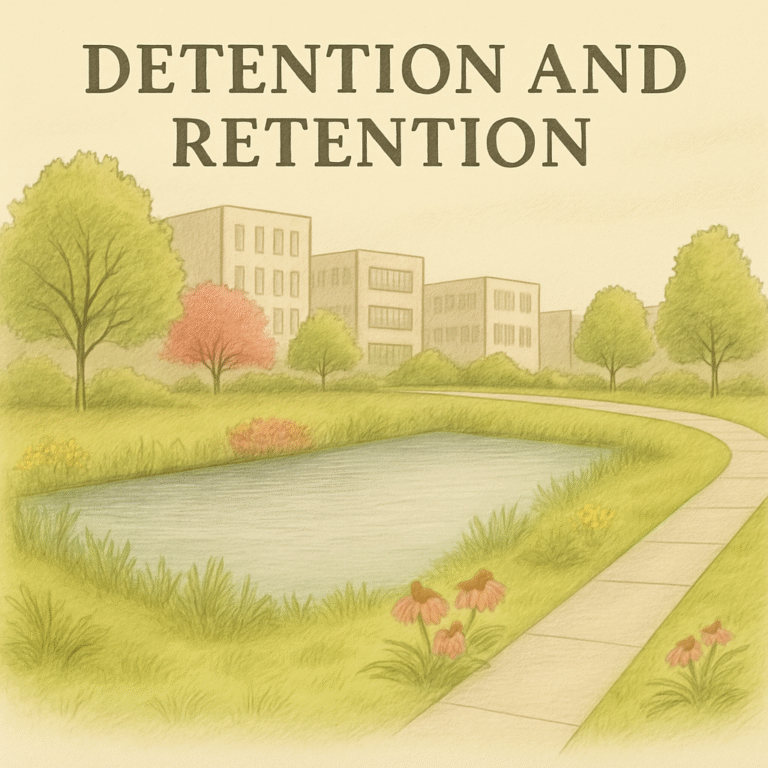When most people imagine a new community, they picture renderings, architecture, or bustling streets. But long before any of that becomes real, a quieter and more decisive process takes place — one that determines whether a project is even buildable:
Can the land be served with reliable utilities?
Utility infrastructure — water, sewer, stormwater, power, broadband, and more — forms the unseen skeleton of development. It shapes density, cost, phasing, and livability. It can accelerate approvals and attract investors — or stall a project for years.
At LAI Design Group, we’ve spent decades helping clients navigate this hidden framework. What follows is a practical, big-picture look at the utility landscape: why it matters, where projects go wrong, and how smart early planning turns invisible systems into competitive advantage.
Why Utilities Decide Feasibility
Land isn’t truly “raw.” Beneath the surface lies a web of municipal systems, private providers, and environmental rules. If those systems can’t handle the load — or can’t reach your site — you may face:
- Costly off-site improvements (extending mains, upgrading lift stations, building regional detention).
- Density reductions because capacity simply doesn’t exist.
- Schedule delays from multi-year permitting or construction.
- Financing challenges when investors see unknown infrastructure risk.
A beautiful plan can be worthless if the utilities can’t support it. Understanding this early is where great projects begin.
Water Supply: The First Gatekeeper
Water availability sets the baseline for density, fire protection, and phasing.
Key considerations include:
- Source & pressure — Can the system deliver enough flow for domestic use and hydrants?
- Tap fees & connection costs — These can reshape pro formas.
- Timing — New mains or storage tanks may lag behind demand.
Early coordination with the water provider avoids late redesigns, unlocks accurate cost modeling, and ensures fire-flow requirements won’t surprise you mid-entitlement.
Sewer & Wastewater: Capacity Sets the Scale
Sewer determines how much — and how soon — you can build. Common pitfalls include:
- Undersized lines or plants that trigger expensive upsizing.
- Limited downstream capacity causing phase caps or moratoriums.
- Pump station needs adding O&M and power cost.
Analyzing capacity and upgrade plans before site layouts are fixed can save millions and preserve density.
Stormwater & Drainage: Where Engineering Meets Design
Stormwater isn’t just about ponds; it can consume developable acres, alter grading, and affect community character.
- Regulatory drivers: MS4 permits, low-impact development (LID), water quality standards.
- Cost & land take: Poor early hydrology can cut yield dramatically.
- Opportunities: Integrated detention can double as parks, trails, or open space.
When addressed early, stormwater can enhance livability and even market value rather than just meet minimum code.
Power & Energy Delivery: The Silent Schedule Killer
Transformer availability, feeder capacity, and utility construction timelines can make or break absorption schedules. Renewable integration and EV charging requirements now add complexity.
- Delays in energization can stall closings and occupancy.
- Coordination with providers ensures correct sizing and early design for switchgear and duct banks.
Proactive planning avoids last-minute redesigns and costly temporary solutions.
Broadband & Connectivity: The New Livability Metric
For both residential and commercial users, high-speed connectivity is non-negotiable.
- Provider commitments should be secured early — don’t assume fiber is nearby.
- Future-proofing: Plan for 5G nodes, smart-building tech, and IoT integration.
Developments without reliable broadband struggle to compete, lease, or sell.
Integrated Utility Planning: LAI’s Approach
Utilities are often treated as an afterthought, handled by separate engineers after the vision is drawn. At LAI, we flip that order:
- Feasibility first — We identify capacity, routing, and costs early.
- Collaborative coordination — We work directly with municipalities, special districts, and private providers.
- Market awareness — We align infrastructure with absorption pacing and cost realities.
- Design integration — Landscape, grading, and stormwater are treated as one system, maximizing usable land.
This approach turns unknowns into controlled variables — critical for lenders, partners, and public approvals.
Common Mistakes to Avoid
- Skipping early due diligence because a site “looks served.”
- Relying on outdated master plans without verifying real capacity.
- Designing grading before stormwater strategy.
- Assuming broadband and power will just show up.
- Waiting until entitlement to talk cost with utility providers.
These missteps routinely add millions and months to projects.
The Payoff of Doing It Right
- Predictable budgets & phasing
- Faster entitlement approvals
- Higher land value and yield
- Stronger financing packages because risk is managed early
- Communities that function day one and scale over time
Partnering with LAI Design Group
Our work spans feasibility studies, entitlement support, master planning, and construction-ready coordination. By bringing utilities into the conversation from the first sketch, we help clients move from vision to buildable, market-ready reality with fewer surprises.
If you’re evaluating a site or kicking off a plan, consider starting with a utility feasibility review. It’s one of the smartest investments you can make.
Let’s Talk About Your Next Project
Reach out to the LAI Design Group team to discuss early utility strategy and see how proactive infrastructure planning can set your development up for success.
#LAIDesignGroup #Infrastructure #Utilities #Planning #Development #Water #Sewer #Stormwater #Power #Broadband #UrbanDesign




